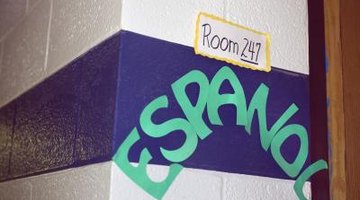Teaching a foreign language can be a challenging task. Language teachers need to be resourceful and able to help their students easily see how the foreign language resembles their native tongue. The increasing prevalence of the Spanish language in the United States makes it a logical choice as a second language to teach kids. According to the American Council on the Teaching of Foreign Languages (ACTFL), teaching a language to students from an early age can prove to be beneficial in improving standardized test and intelligence quotient (I.Q.) test scores.
Schedule and Intensity
The ACTFL recommends a minimum of 75 minutes of foreign language instruction each week. Classes should meet three times per week on an every-other-day schedule. There are different intensity levels that you can teach as well. The ACTFL recognizes three: foreign language experience (FLEX), sequential learning and immersion. Of these three approaches, immersion is the most intense because it involves introducing students to a foreign language, such as Spanish, in the school's other curriculum programs. If this is not a feasible option, you can always develop a list of vocabulary words that the students might encounter in other subjects and encourage them to use them in their other studies. In any case, incorporate a holistic approach to teaching Spanish. Mary Lynn Redmond, director of foreign language education at Wake Forest University, says this aids in the process of learning a foreign language and also proves helpful for students with different learning styles.
Instructional Materials
In order to incorporate a holistic approach, your instructional materials should include a wide variety of sources. Use sources that teach Spanish through reading, writing and conversation in order to ensure that your students are introduced to all aspects of the language. If possible, use media that students are already familiar with, such as MP3 downloads, digital video and Internet resources, in order to stimulate their desire to learn. If they can see how language study corresponds to their own activities, it may stimulate their desire to learn as much about the language as possible. A number of websites, such as Teachnology, which is linked in the Resources section, have multiple resources available for variety-based instruction.
Reinforcement
Studying Spanish, like any other subject, requires proper reinforcement in order to promote long-term retention of the language. Students are likely to be curious about Hispanic culture as a result of their study of Spanish. Introducing students to songs, artwork and other whole-brain activities will help stimulate learning and long-term memory of the language. By focusing on creative and meaningful activities for the students, you can avoid teaching by rote memorization and other methods that can cause studying Spanish to become a mundane activity.
Related Articles
Writer Bio
Jared Lewis is a professor of history, philosophy and the humanities. He has taught various courses in these fields since 2001. A former licensed financial adviser, he now works as a writer and has published numerous articles on education and business. He holds a bachelor's degree in history, a master's degree in theology and has completed doctoral work in American history.











